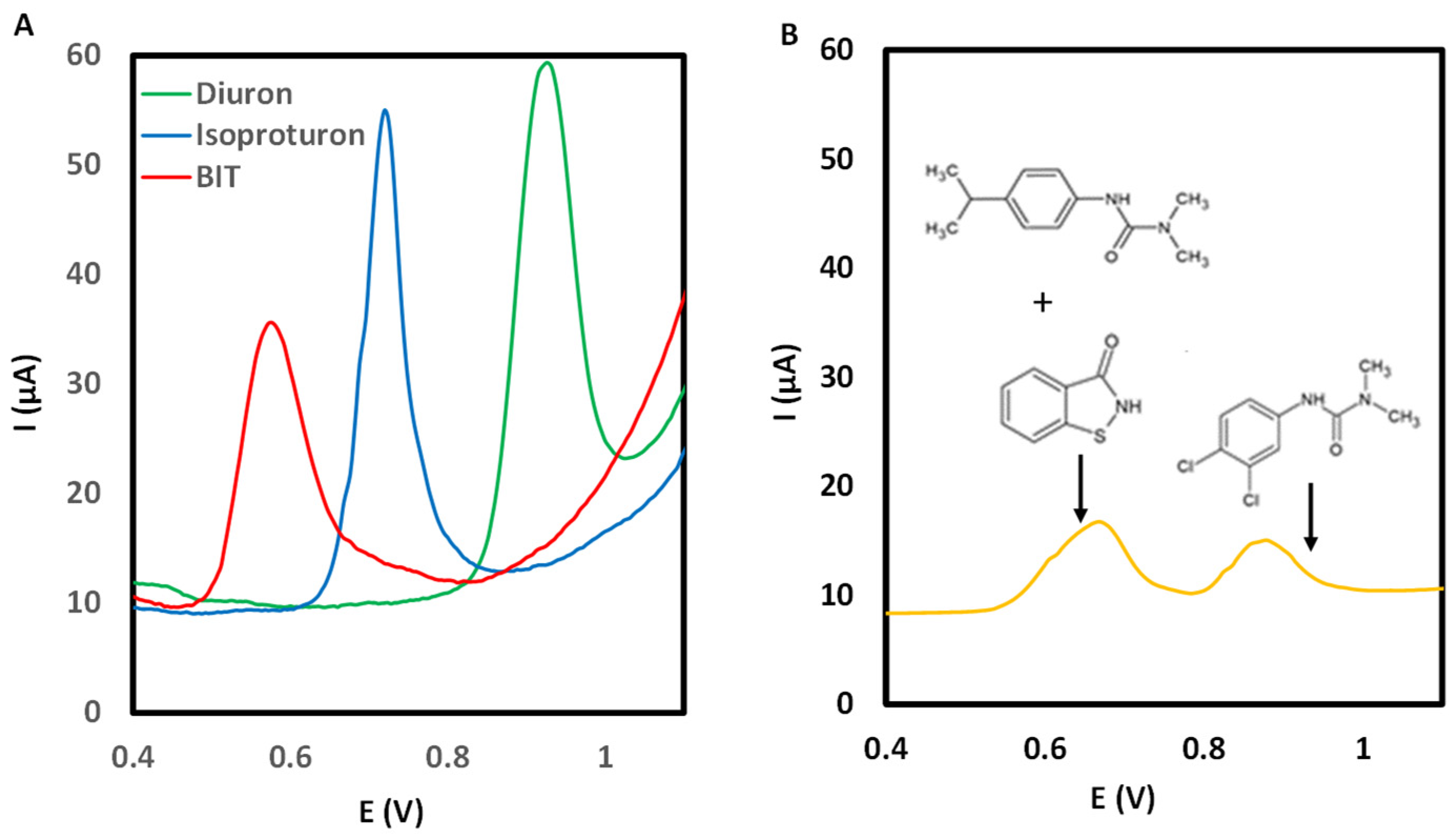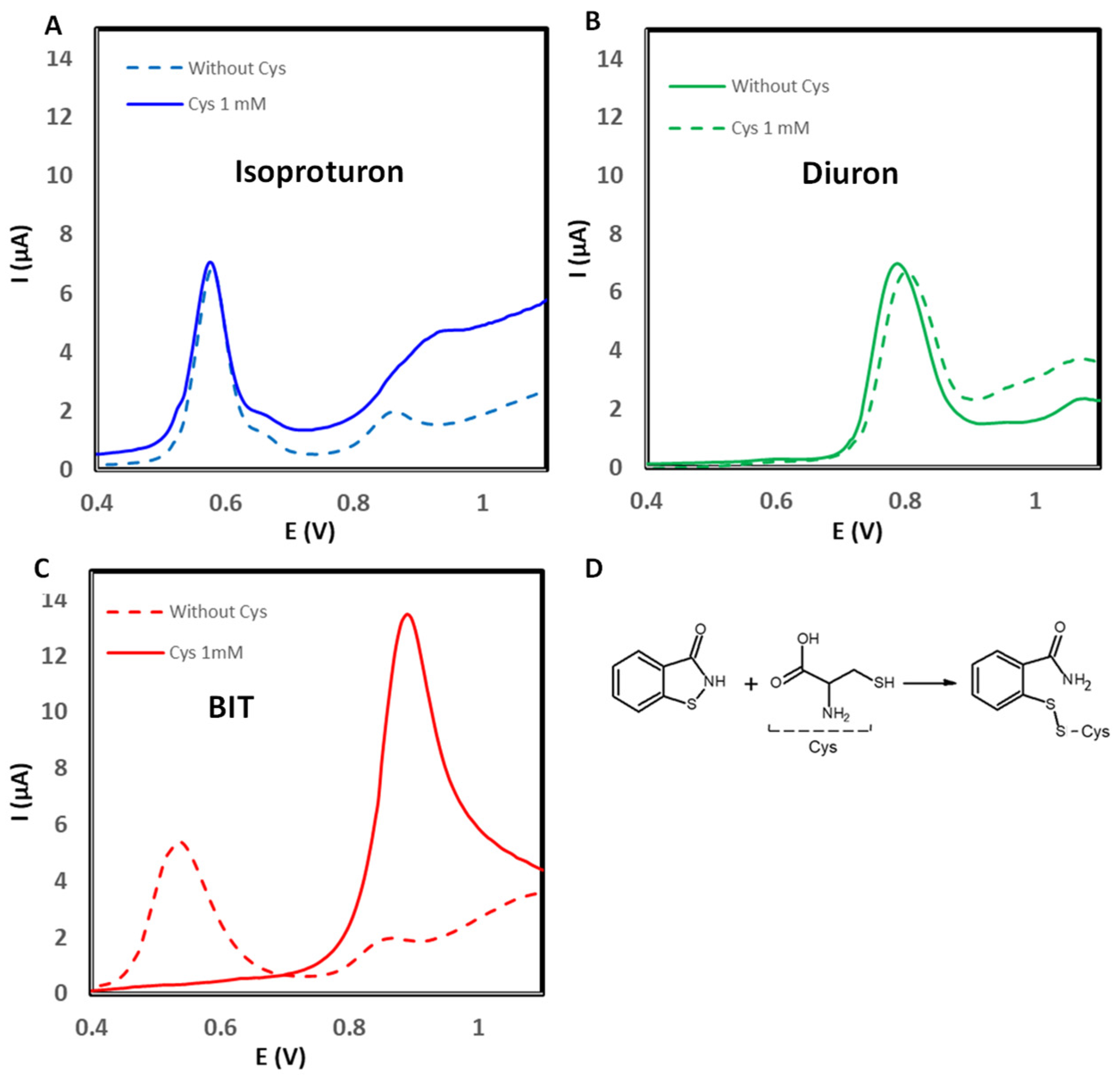Towards Portable One-Drop Voltammetry with Doped Screen-Printed Electrodes to Control Preservatives: A New Tool for Diuron and Isoproturon in the Paint Industry
Abstract
1. Introduction
2. Materials and Methods
2.1. Reagents and Solutions
2.2. Apparatus
2.3. Optimization of the Electrochemical Signal
2.4. Analysis of Paint Samples
3. Results and Discussion
3.1. Optimization of the Electrochemical Response
3.2. Study of the Cysteine (Cys) Addition for Increasing Selectivity
3.3. Analytical Parameters
3.4. Analytical Performance in the Paint Industry
4. Conclusions
Author Contributions
Funding
Data Availability Statement
Conflicts of Interest
References
- Paints and Coatings Market Size and Share Analysis. Available online: https://ceresana.com/en/produkt/paints-and-coatings-market-report-europe (accessed on 1 October 2022).
- Urbancyk, M.M.; Bester, K.; Borho, N.; Schoknecht, U.; Bollman, U.E. Influence of pigment on phototransformation of biocides in paints. J. Hazard. Mat. 2018, 364, 125–133. [Google Scholar] [CrossRef] [PubMed]
- Schoknecht, U.; Mathies, H. The impact of weather conditions on biocides in paints. Materials 2022, 15, 7368. [Google Scholar] [CrossRef] [PubMed]
- Schoknecht, U.; Mathies, H.; Lisec, J. Leaching and Transformation of Film Preservatives in Paints Induced by Combined Exposure to Ultraviolet Radiation and Water Contact under Controlled Laboratory Conditions. Water 2021, 13, 2390. [Google Scholar] [CrossRef]
- Ulla, E.; Bollmann, U.E.; Ou, Y.; Mayer, P.; Trapp, S.; Bester, K. Polyacrylate–water partitioning of biocidal compounds: Enhancing the understanding of biocide partitioning between render and water. Chemosphere 2015, 119, 1021–1026. [Google Scholar] [CrossRef]
- Styszkoa, K.; Bollmannb, U.E.; Wanglerc, T.P.; Bester, K. Desorption of biocides from renders modified with acrylate and silicone. Chemosphere 2014, 95, 187–191. [Google Scholar] [CrossRef]
- EUR-Lex-31998L0008-EN-EUR-Lex. Available online: https://eur-lex.europa.eu/legal-content/EN/TXT/?uri=celex%3A31998L0008 (accessed on 4 December 2022).
- EUR-Lex-32007R1451-EN-EUR-Lex. Available online: https://eur-lex.europa.eu/legal-content/EN/TXT/?uri=celex%3A32007R1451 (accessed on 4 December 2022).
- EUR-Lex-32012R0528-EN-EUR-Lex. Available online: https://eur-lex.europa.eu/legal-content/EN/TXT/?uri=celex%3A32012R0528 (accessed on 4 December 2022).
- Müller, B.; Poth, U. Coatings Formulation: An International Textbook, 2nd ed.; Editorial Vincentz: Hanover, Germany, 2011. [Google Scholar]
- Jang, H.; Lee, J.; Choi, H.; Nam, T.; Kim, S.; Lee, K. Analytical Method Validation for Terbutryn Using Gas Chromatography/Ion Trap, Gas Chromatograph/Mass Selective Detector, and Liquid Chromatography/Triple Quadrupole Mass Spectrometers. Food Sci. Biotechnol. 2018, 27, 1525–1530. [Google Scholar] [CrossRef]
- Marrero-Alemán, G.; Borrego, L.; Antuña, A.; Macías Montes, A.; Pérez Luzardo, O. Isothiazolinones in Cleaning Products: Analysis with Liquid Chromatography Tandem Mass Spectrometry of Samples from Sensitized Patients and Market. Contact Derm. 2020, 82, 94–100. [Google Scholar] [CrossRef]
- Pitarch-Andrés, S.; Roca-Genovés, P.; Peris-Vicente, J.; Esteve-Romero, J. Determination of Diuron, Terbuthylazine, and Terbutryn in Wastewater and Soil by Micellar Liquid Chromatography. Anal. Bioanal. Chem. 2017, 409, 2037–2049. [Google Scholar] [CrossRef]
- Shah, J.; Rasul, J.M.; Ara, B.; Shehzad, F. Quantification of Triazine Herbicides in Soil by Microwave-Assisted Extraction and High-Performance Liquid Chromatography. Environ. Monit. Assess. 2011, 178, 111–119. [Google Scholar] [CrossRef]
- Su, M.; Jia, L.; Wu, X.; Sun, H. Residue Investigation of Some Phenylureas and Tebuthiuron Herbicides in Vegetables by Ultra-Performance Liquid Chromatography Coupled with Integrated Selective Accelerated Solvent Extraction-Clean up in Situ. J. Sci. Food Agric. 2018, 98, 4845–4853. [Google Scholar] [CrossRef] [PubMed]
- Luft, A.; Wagner, M.; Ternes, T.A. Transformation of Biocides Irgarol and Terbutryn in the Biological Wastewater Treatment. Environ. Sci. Technol. 2011, 48, 244–254. [Google Scholar] [CrossRef]
- Booij, P.; Sjollema, S.; van der Geest, H.; Leonards, P.; Lamoree, M.; de Voogt, W.; Admiraal, W.; Laane, R.; Vethaak, A. Toxic Pressure of Herbicides on Microalgae in Dutch Estuarine and Coastal Waters. J. Sea. Res. 2015, 102, 48–56. [Google Scholar] [CrossRef]
- Howe, P.; Reichelt-Brushett, L.A.; Clark, M.; Seery, C. Toxicity Estimates for Diuron and Atrazine for the Tropical Marine Cnidarian Exaiptasia Pallida and In-Hospite Symbiodinium spp. Using PAM Chlorophyll-a Fluorometry. J. Photochem. Photobiol. B Biol. 2017, 171, 125–132. [Google Scholar] [CrossRef]
- Sharma, P.; Gandhi, S.; Chopra, A.; Sekar, N.; Raman Suri, C. Fluoroimmunoassay Based on Suppression of Fluorescence Self-Quenching for Ultra-Sensitive Detection of Herbicide Diuron. Anal. Chim. Acta 2010, 676, 87–92. [Google Scholar] [CrossRef] [PubMed]
- Carpio, A.; Esquivel, D.; Arce, L.; Romero-Salguero, F.; Van der Voort, P.; Jimenez-Sanchidrián, C.; Válcarcel, M. Evaluation of Phenylene-Bridged Periodic Mesoporous Organosilica as a Stationary Phase for Solid Phase Extraction. J. Chromatogr. A. 2014, 1370, 25–32. [Google Scholar] [CrossRef]
- Mugadza, T.; Nyokong, T. Facile Electrocatalytic Oxidation of Diuron on Polymerized Nickel Hydroxo Tetraamino-Phthalocyanine Modified Glassy Carbon Electrodes. Talanta 2010, 81, 1373–1379. [Google Scholar] [CrossRef]
- Noyrod, P.; Chailapakul, O.; Wonsawat, W.; Chuanuwatanakul, S. The Simultaneous Determination of Isoproturon and Carbendazim Pesticides by Single Drop Analysis Using a Graphene-Based Electrochemical Sensor. J. Electroanal. Chem. 2014, 719, 54–59. [Google Scholar] [CrossRef]
- Ruiz Montoya, M.; Giráldez, I.; Morales, E.; Estévez Brito, R.; Rodriguez Mellado, J. Electrochemical Oxidation of Isothiazolinone Biocides and Their Interaction with Cysteine. Electrochim. Acta 2020, 337, 1357–1370. [Google Scholar] [CrossRef]
- Selesovska, R.; Janikova, L.; Pithardtova, K.; Chylkova, J.; Tomaskova, M. Sensitive Voltammetric Determination of Herbicide Terbutryn Using Solid Electrodes Based on Silver Amalgam and Boron-Doped Diamond. Monatsh. Chem. 2016, 147, 207–217. [Google Scholar] [CrossRef]
- Wong, A.; Foguel, M.; Khan, S.; Oliveira, F.; Tarley, C.; Sotomayor, M. Development of an electrochemical sensor modified with mwcnt-cooh and mip for detection of diuron. Electrochim. Acta 2015, 182, 122–130. [Google Scholar] [CrossRef]
- Dindar, K.; Erkmen, C.; Uslu, B. Electroanalytical methods based on bimetallic nanomaterials for determination of pesticides: Past, present, and future. Trends Environ. Anal. Chem. 2021, 32, e00145S. [Google Scholar] [CrossRef]
- Harma, P.; Bhalla, V.; Tuteja, S.; Kukkar, M.; Suri, R. Rapid Extraction and Quantitative Detection of the Herbicide Diuron in Surface Water by a Hapten-Functionalized Carbon Nanotubes Based Electrochemical Analyzer. Analyst 2012, 137, 2495–2502. [Google Scholar]
- Nasir, T.; Gamero-Quijano, A.; Despas, C.; Dossot, M.; Herzog, G.; Walcarius, A. Signal Amplification by Electro-Oligomerisation for Improved Isoproturon Detection. Talanta 2020, 220, 121347. [Google Scholar] [CrossRef]
- Sadriu, I.; Bouden, S.; Nicolle, J.; Podvorica, F.; Bertagna, V.; Berho, C.; Amalric, L.; Vautrin, C. Molecularly Imprinted Polymer Modified Glassy Carbon Electrodes for the Electrochemical Analysis of Isoproturon in Water. Talanta 2020, 207, 120222. [Google Scholar] [CrossRef]
- Moraswki, F.; Winiarski, J.P.; Maduro de Campos, C.E.; Parize, A.L.; Jost, C.L. Sensitive simultaneous voltametric determination of herbicides diuron and isoproturon at a platinum/chitosan bio-based sensing platform. Ecotoxicol. Environ. Saf. 2020, 206, 111181. [Google Scholar] [CrossRef]
- Soares, F.S.; Ramalho, R.T.E.; Silva, A.C.; Araujo, M.C.U. Very Sensitive A voltametric method for diuron determination in river water. Electroanalysis 2023, 35, e202200486. [Google Scholar] [CrossRef]
- Li, S.; Xie, Q.; Yang, M.; Wu, N.; Lian, Y.; Fang, C. Degradation of leachate and high concentration emerging pollutant tetracycline through electro oxidation. J. Environ. Sci. 2026, 159, 142–153. [Google Scholar] [CrossRef]
- Cobb, S.J.; Macpherson, V.J. Enhancing Square Wave Voltammetry Measurements via Electrochemical Analysis of the Non-Faradaic Potential Window. Anal. Chem. 2019, 91, 7935–7942. [Google Scholar] [CrossRef]
- Wu, J.; Xiaodong, Y.; Wang, T.; Zhang, Y.; Jin, Y.; Li, G. A cost-effective and sensitive voltametric sensor for determination of baicalein in herbal medicine based on shuttle-shape α-Fe2O3 nanoparticle decorated multi-walled carbon nanotubes. Colloids Surf. A Physicochem. Eng. Asp. 2025, 717, 136850. [Google Scholar] [CrossRef]
- Xie, L.; Liu, L.; Xu, S.; Wang, T.; Yue, X.; Li, G. An efficient voltametric sensing platform for trace determination of Norfloxacin based on nanoplate-like-zirconium phosphate/carboxylated multiwalled carbon nanotube nanocomposites. Microchem. J. 2024, 206, 111451. [Google Scholar] [CrossRef]
- Salazar, P.; García-García, F.J.; González-Elipe, A. Sensing and biosensing with screen printed electrodes modified with nanostructured nickel oxide thin films prepared by magnetron sputtering at oblique angles. Electrochem. Commun. 2018, 94, 5–8. [Google Scholar] [CrossRef]
- Ballester-Caudet, A.; Campíns-Falcó, P.; Pérez, B.; Sancho, R.; Lorente, M.; Sastre, G.; González, C. A new tool for evaluating and/or selecting analytical methods: Summarizing the information in a hexagon. TrAC Trends Anal. Chem. 2019, 118, 538–547. [Google Scholar] [CrossRef]
- Nowak, P.M.; Kościelniak, P.; Tobiszewski, M.; Ballester-Caudet, A.; Campíns-Falcó, P. Overview of the three multicriteria approaches applied to a global assessment of analytical methods. TrAC Trends Anal. Chem. 2020, 133, 116065. [Google Scholar] [CrossRef]
- Zhou, Y.; Cheng, F.; Hong, Y.; Huang, J.; Zhang, X.; Liao, X. Rapid and sensitive detection of isoproturon via an electrochemical sensor based on highly water-dispersed carbon hybrid material. Food Anal. Methods 2020, 13, 839–849. [Google Scholar] [CrossRef]
- Silva, L.R.G.; Rodrigues, J.G.A.; Franco, J.P.; Santos, L.P.; Délia, E.; Romao, W.; Ferreira, R.Q. Development of a portable electroanalytical method using nickel modified screen-printed carbon electrode for ethinylestradiol determination in organic fertilizers. Ecotoxicol. Environ. Saf. 2021, 208, 111430. [Google Scholar] [CrossRef]
- Silva, V.; Silva, C.; Soares, P.; Garrido, M.; Borges, F.; Garrido, J. Isothiazolinone biocides: Chemistry, Biological and toxicity profiles. Molecules 2020, 25, 991. [Google Scholar] [CrossRef]
- Pla-Tolós, J.; Serra-Mora, P.; Hakobyan, L.; Molins-Legua, C.; Moliner- Martinez, Y.; Campíns-Falcó, P. A sustainable on-line CapLC method for quantifying antifouling agents like irgarol-1051 and diuron in water samples: Estimation of the carbon footprint. Sci. Total Environ. 2016, 569–570, 611–618. [Google Scholar] [CrossRef] [PubMed]
- Jiménez, J.; De la Cruz, L.; Carballo, J.; Domenech, A. Enfoques Metodológicos Para el Cálculo de la Huella de Carbono; OSE Estudios Gráficos Europeos, S.A.: Madrid, Spain, 2011. [Google Scholar]
- Martínez-Pérez-Cejuela, H.; Gionfriddo, E.; Campíns-Falcó, P.; Herrero-Martínez, J.M.; Armenta, S. Green and sustainable evaluation of methods for sample treatment in drug analysis. Green Anal. Chem. 2024, 10, 100125. [Google Scholar] [CrossRef]
- Xiong, Q.; Yuan, Z.; Zhang, Y.; Chen, Z.; Wei, K.; Ma, W. A new approach for separating copper, tin, and lead from photovoltaic ribbon wastes. Sol. Energy 2025, 299, 113810. [Google Scholar] [CrossRef]







| Analytical Parameters | ||
|---|---|---|
| Isoproturon | Diuron | |
| a ± sa | −1.7 ± 1.7 | −0.6 ± 1.0 |
| b1 ± sb (L mg−1) | 0.85 ± 0.06 | 1.00 ± 0.04 |
| R2 | 0.9913 | 0.9970 |
| LOD (mg L−1) | 3.5 | 3.0 |
| * RSD (%), n = 10 | 6.8 | 7.5 |
| Labeled Concentration (mg L−1) | Found Concentration (mg L−1) | |||
|---|---|---|---|---|
| Isoproturon | Diuron | Isoproturon | Diuron | |
| Sample 1 | 50.0 | 50.0 | 46 ± 4 | 49 ± 2 |
| Sample 2 | 25.0 | 12.5 | 23 ± 3 | 13 ± 3 |
Disclaimer/Publisher’s Note: The statements, opinions and data contained in all publications are solely those of the individual author(s) and contributor(s) and not of MDPI and/or the editor(s). MDPI and/or the editor(s) disclaim responsibility for any injury to people or property resulting from any ideas, methods, instructions or products referred to in the content. |
© 2025 by the authors. Licensee MDPI, Basel, Switzerland. This article is an open access article distributed under the terms and conditions of the Creative Commons Attribution (CC BY) license (https://creativecommons.org/licenses/by/4.0/).
Share and Cite
Huertas-Bastidas, S.; Moliner-Martínez, Y.; Campíns-Falcó, P. Towards Portable One-Drop Voltammetry with Doped Screen-Printed Electrodes to Control Preservatives: A New Tool for Diuron and Isoproturon in the Paint Industry. Sensors 2025, 25, 6987. https://doi.org/10.3390/s25226987
Huertas-Bastidas S, Moliner-Martínez Y, Campíns-Falcó P. Towards Portable One-Drop Voltammetry with Doped Screen-Printed Electrodes to Control Preservatives: A New Tool for Diuron and Isoproturon in the Paint Industry. Sensors. 2025; 25(22):6987. https://doi.org/10.3390/s25226987
Chicago/Turabian StyleHuertas-Bastidas, Sergio, Yolanda Moliner-Martínez, and Pilar Campíns-Falcó. 2025. "Towards Portable One-Drop Voltammetry with Doped Screen-Printed Electrodes to Control Preservatives: A New Tool for Diuron and Isoproturon in the Paint Industry" Sensors 25, no. 22: 6987. https://doi.org/10.3390/s25226987
APA StyleHuertas-Bastidas, S., Moliner-Martínez, Y., & Campíns-Falcó, P. (2025). Towards Portable One-Drop Voltammetry with Doped Screen-Printed Electrodes to Control Preservatives: A New Tool for Diuron and Isoproturon in the Paint Industry. Sensors, 25(22), 6987. https://doi.org/10.3390/s25226987







